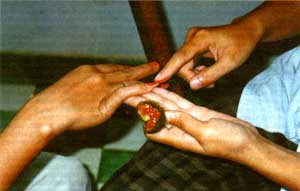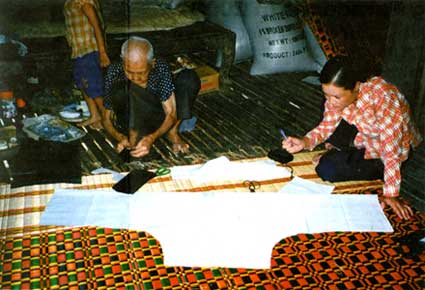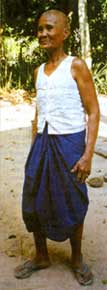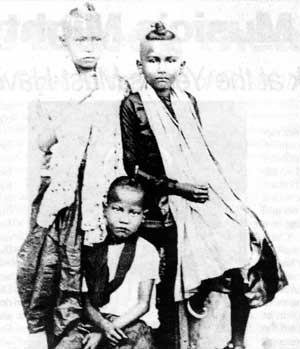|
from the Cambodia Daily, January 3-4, 2004
Fleeting Beauty
Book Recalls
Clothing, Cosmetics and
Personal Care in 19th and 20th Centuries
by MICHELLE
VACHON AND KUCH NAREN
In a
not-so-distant past beauty for a married Cambodian woman
meant blackening her teeth by chewing betel. Married women
with white teeth in the countryside would be criticized and
considered sickly pale.
Chewing
betel, which also reddens the lips, was supposed to keep
one's teeth clean and breath fresh. Women would apply wax on
their lips before ceremonies and special occasions to
prevent betel juice from running out of their mouths and
staining their clothes.
By the 1950s,
this habit had Men out of favor, especially in urban areas.
In the newly-independent country, students and government
workers opted to keep their teeth white.
In addition,
pitting—which a person chewing betel can hardly avoid, since
it makes one salivate—was prohibited in public places.
Today, only elderly women and a few men chew betel.
These are
some of the Cambodian customs mentioned in the book, "Seams
of Change," which will be released Tuesday at the opening of
an exhibition of clothes and objects at the Reyum Institute
of Arts and Culture. It was written by four archeology
graduates from the Royal University of Fine Arts who now
work as researchers for the institute.
As its
subtitle indicates, the 295-page book describes, in English
and in Khmer, "Clothing and the Care of the Self in Late
19th and 20th Centuries." The book is based on a series of
interviews with elderly Cambodians and includes descriptions
of clothes; sewing methods, patterns and tools; hair and
jewelry styles; and washing products for clothes and for
personal care.
The book is built on the memories of 40 people whose
recollections stretch nearly a century. The eldest
contributor is Pou Kech Lang, who was born in 1907 in Kandal
province. The youngest contributor, Lem Hok Cheang, was bom
in 1940 in Kompong Thorn province.
Previous
research on Cambodia's "official" history has focused on
personalities and political events, according to the
introduction written by Chea Narin, Chea Sopheary, Kem
Sonine and Preap Chanmara, authors of the book.
But "if we
want to know about everyday life and experiences of ordinary
people during this period, these official histories do not
offer us much information," they wrote.
For example,
old people sometimes talk about "wearing the water jar" or
the "tin gas tank," the authors said. These expressions
refer to the shortage of clothes and fabric during World War
II, when thread was requisitioned for the Japanese war
effort.
 |
|
Courtesy of the Reyum Institute of Arts and Culture
Demonstrators show how women crushed seeds from the
jumpuh fruit to color their nails in the 1910s and
1920s. Women would do this only for their weddings
or special occasions. |
|
|
Some families
in remote areas had only one set of clothing for the whole
family, which one family member would wear to run errands
while the others hid, virtually naked, in the house. If a
visitor came while he and the clothes were away, one family
member would hide behind the gas can or sit in the water jar
while talking to the visitor.
The authors
discovered the origins of the expression "jip tong" by which
Cambodians sometimes call the popular rubber sandals with a
thong between the big and second toes.
 |
|
 |
|
(Left) Mrs
Mich, 88, shows Reyum researcher Chea Sopheary how to make a santeh shirt in
Kandal province last year. Traditionally cut from a single piece of cloth
without shoulder seams, this shirt was commonly worn by both men and women.
(Right)
An elderly woman from Siem Reap
province wears a traditional leak undershirt with pockets at the front—in the
past, women did not carry wallets or purses—and a sampot in the kben, or baggy
pants, style. |
Jip Tong was
the name of a factory known for its quality thongs, or
flip-flops, in the 1950s and 1960s. Cambodians also call the
sandals "ptoat" because they make a slapping sound and lift
dust when walking, the authors added.
The custom of
wearing shoes or sandals was introduced by the French in the
late 19th century, they said. Up until then, Cambodians had
gone barefoot However, while this new fashion was embraced
in the cities, it far from swept the countryside, as
80-year-old Ong Sok told the authors.
"When someone wore shoes [in the 1920s], my mother would
stare and criticize diem. People in our village [in Kandal
province] didn't wear them."
The first sandals in the countryside were made of palm tree
bark or roluos wood, with straps of vine or strips of
canvas, nylon bag or tire rubber, the authors said.
Some sandals
were constructed of thick pieces of wood, said 79-year-old
Sim Saren of Prey Veng province. "When there were fights,
they would use their shoes to hit each other on the head,"
he said. "So they stopped wearing thick shoes."
Shoe
factories appeared in the 1950s, and people switched to
manufactured shoes, said the authors. But poor farmers
continued to make their own for some time, buying one pair
of factory-made shoes for special occasions when they could
afford it, they said.
People also
made their clothes themselves with thread and needle; they
had few of them and had to make them last a long time.
"People
patched pants so many times, and wore them so long that they
became...just patches," said 88-year-old Mich of Kandal
province. People only had "two pairs of clothing for house
wear, two pairs of clothing for working, and two pairs of
clothing for ceremonial occasions," she said.
Since washing
aged fabric, people would just spread their clothes to let
the sweat evaporate and then store them, said Mich. In the
case of fine fabric, they would sprinkle the clothes with
water and carefully smooth and stretch them with their
hands, she said.
The section
of the book on undergarments shows camisoles that older
women still wear as blouses at home. In the past unmarried
women had to wear them very tight to flatten their chest the
ones who failed to do so were viewed with suspicion, said
the authors.
Numerous
customs involved people's hair, they said. Shortly after the
birth of the baby, a hair-cutting ceremony would be held to
announce his or her arrival in the world. At around age 13,
a child's head was shaved, leaving only a strand at the
front to mark puberty. The hair-cutting ritual still
performed at weddings today signifies mat the spouses are
entering a new phase of their lives.
Married women
wore their hair short, some of them only a few centimeters
long. Only unmarried women and women of Chinese background
wore long hair, usually tied in a bun.
For washing, people made ash soaps from various plants and
flowers, said the authors. Manufactured soaps and shampoos
became affordable to a larger number of people only in the
mid-1950s, the authors said.
 |
|
Courtesy of the Notional Archives of Cambodia
This photo, taken around the late 19th century,
shows children with their hair cut in the duk juk
style to show they had reached puberty. Their heads
were shaved except for a long strand in the center. |
|
|
This book
contains just a portion of the material accumulated by
Reyum's nine researchers. Two years ago, they started
interviewing more than 100 elderly people on all aspects of
life and customs in Cambodia and entering their
recollections in a database to preserve oral history in a
true "memory bank"
This had to
be done without delay, said Chea Sopheary. "I was afraid
that so much about the past would remain unknown or be lost
when those elderly people would pass away," she said.
'They were happy to talk when we asked about their daily
lives. They told us this was the first time they had a
chance to speak out".
As the
project evolved, Chea Narin, Chea Sopheary, Kem Son-ine and
Preap Chanmara became interested in the information they
were getting on clothes and personal care, and decided to
turn it into a book, Chea Narin said.
The book
shows the clothes and habits of ordinary people, she said.
"I had never seen or heard of some styles of clothes
described in the interviews, while others are still worn
today.
The long-tube
shirt, which was a long-sleeve tunic reaching below the
knees, used to be popular among women of all ages. Now, only
a few older women wear it for special occasions.
On the other
hand, a piece of others are stifl worn today." fabric, or
sampot, tied in the traditional kben style to form baggy
pants continues to be worn for ceremonies at the Royal
Palace, and Cambodian women regularly wear the sampot tied
in the samloy style as a long wraparound skirt.
During the
interviews, Kem Sonine was struck by the difference of
perception between elderly men and women. Since they were
kept at home to team household chores, women were not aware
of social problems, she said.
"They could
only answer questions regarding themselves or personal
matters," she said. Men, who as youths were sent to study at
the pagoda, had a much better understanding of social
issues, Kem Sonine said.
Based on
these findings, the four researchers want to explore
education and training practices in a second book, Chea
Sopheary said.
The
exhibition, which will run through March, will feature some
of the beauty products women made, such as the jumpuh fruit
used to color nails red and the tumeric powder they applied
to whiten and improve their skin.
Even though
rural women occasionally colored their lips or nails, they
generally used no makeup outside of ceremonies, the authors
said. A woman was valued for her competence in household and
domestic matters and not so much for her appearance, they
said.
The research
was funded by the Rockefeller Foundation, with additional
support from the Kasumisou Foundation and the Albert
Kunstadter Family Foundation.
|